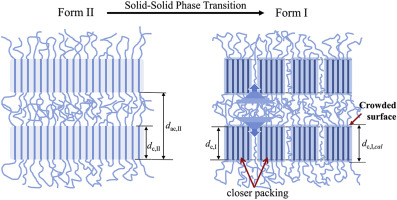Polymer ( IF 4.6 ) Pub Date : 2020-03-30 , DOI: 10.1016/j.polymer.2020.122425 Yongna Qiao , Martha Schulz , Hai Wang , Ran Chen , Mareen Schäfer , Thomas Thurn-Albrecht , Yongfeng Men

|
Polybutene-1 (PB-1) exhibits excellent mechanical properties, while an unavoidable polymorphic transition from a metastable form II to the stable form I occurs after solidification from the molten state. This transition goes along with a deformation of the crystal lattice corresponding to a lateral shrinkage and normal elongation of about 20% and 12%, respectively. Here we study the semicrystalline morphology before and after the transition using small-angle X-ray scattering (SAXS) and differential scanning calorimeter (DSC). Scattering curves of samples with form II crystals could be well described by a model of layer-like stacked lamellar crystals. However, the scattering signal of form I samples showed additional scattering contributions at higher scattering vectors, indicating the generation of fine structures during the transition, much smaller than lamellar long spacing. The lamellar thickness increased less than the factor of 1.12, expected from the elongation of the lattice. The results indicate that the large lamellar crystals split up into blocks during the transition creating new interstitial spaces within the lamellae. This process is caused by the fact that the laterally extended lamella of form II cannot shrink as a whole due to the connectivity of the chains emanating from the crystals and due to possible overcrowding of the chain segments at the crystalline/amorphous interfaces.
中文翻译:

小角X射线散射揭示晶型II至I的固-固转变导致晶体块中的聚丁烯-1的分层结构
聚丁烯-1(PB-1)表现出优异的机械性能,而从熔融态固化后,发生了不可避免的多晶型转变,从亚稳型II到稳定型I。这种转变伴随着晶格的变形,分别对应于约20%和12%的横向收缩和法向伸长。在这里,我们使用小角度X射线散射(SAXS)和差示扫描量热仪(DSC)研究过渡前后的半晶体形态。II型晶体样品的散射曲线可以通过层状堆叠层状晶体模型很好地描述。但是,形式I样品的散射信号在较高的散射矢量处显示出其他散射贡献,表明在过渡过程中产生了精细结构,比层状长间距小得多。层状厚度的增加小于晶格伸长所预期的1.12倍。结果表明,大的层状晶体在转变过程中分裂成块,从而在层内形成了新的间隙空间。该过程是由于以下事实引起的:由于晶体发出的链的连接性以及晶体/非晶界面上链段的可能过度拥挤,II型横向延伸的薄片无法整体收缩。


























 京公网安备 11010802027423号
京公网安备 11010802027423号